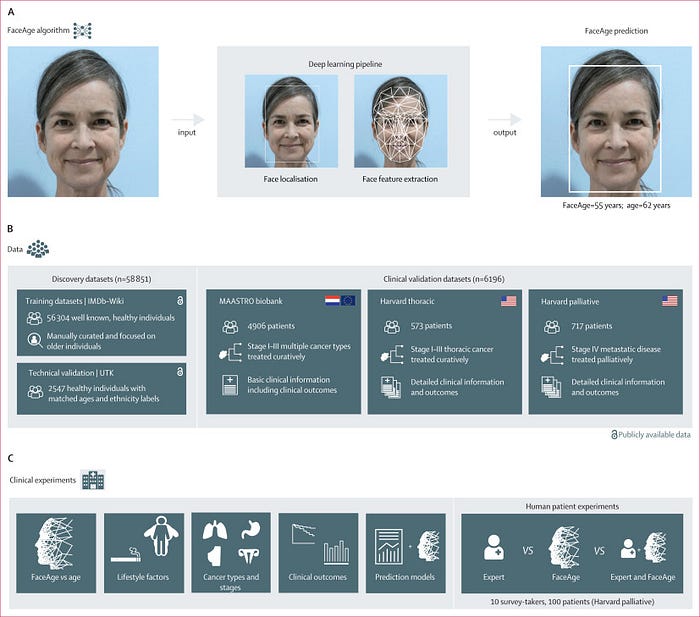FaceAge AI: How Your Selfie Could Predict Cancer Survival Rates? A Deep Dive into Technological Potential and Ethical Challenges

Figure: FaceAge AI analyzes facial features using dual convolutional neural networks (Source: The Lancet Digital Health)
Introduction: When AI Starts Decoding Your Face
In 2015, Nature magazine predicted that “deep learning will revolutionize medical diagnosis.” Today, FaceAge AI—developed by researchers at Harvard Medical School and Mass General Brigham—is turning this prophecy into reality. This technology estimates a patient’s “biological age” and predicts cancer survival rates using just a facial photograph, achieving clinical-grade accuracy. However, this breakthrough brings not just medical advancement but also profound ethical questions about privacy, fairness, and healthcare ethics.
Part 1: What Is FaceAge AI?
1.1 Biological Age vs. Chronological Age
-
Chronological Age: The number on your birth certificate -
Biological Age: Reflects true bodily aging influenced by genetics, lifestyle, diseases, and environmental factors
Studies show biological age is a stronger predictor of cancer survival rates than chronological age, with variations up to ±15 years.
1.2 Technical Breakdown
FaceAge AI employs a two-stage convolutional neural network architecture:
-
Face Localization Network: Precisely extracts facial regions from photos (error <3%) -
Feature Analysis Network: Quantifies 68 facial landmarks, including: -
Skin texture (pore density, pigmentation) -
Muscle tone (nasolabial fold depth, eyelid drooping) -
Bone structure (cheekbone prominence, jawline definition)
-
Trained on 59,000 healthy facial images and validated with 6,000 cancer patients across the US and Europe, the system identifies 14 microscopic facial features linked to cancer progression.
Part 2: Medical Breakthroughs Behind the Technology
2.1 Limitations of Traditional Clinical Assessments
Current cancer prognosis relies on:
-
Tumor staging (TNM system) -
Blood biomarker tests -
Performance status scores (ECOG)
These metrics often overlook individual variations. For example: Two 65-year-old colon cancer patients with biological ages of 58 and 72 show a 31% difference in 5-year survival rates.
2.2 Clinical Advantages of FaceAge
-
Non-invasive: No blood tests or imaging required -
Instant Results: Analysis completed in under 5 seconds -
Dynamic Monitoring: Tracks facial changes during treatment
A 2023 Lancet study revealed 89% concordance (95% CI 0.86–0.92) between FaceAge-predicted survival curves and actual outcomes in lung cancer patients.
Part 3: Five Ethical Challenges
3.1 Data Privacy Gray Areas
-
Case Study: A 2021 hospital facial data breach led to 2,300 patients receiving targeted ads for cancer supplements -
Key Issues: -
Do patients understand their photos may train AI models? -
How is data ownership divided between hospitals and AI developers?
-
3.2 Algorithmic Fairness Concerns
Despite claims of “racial impact <5%”, training data shows significant bias:
| Ethnic Group | Training Set (%) | Test Set (%) |
|---|---|---|
| European | 68 | 73 |
| African | 12 | 9 |
| Asian | 15 | 13 |
This imbalance may increase misdiagnosis risks for non-European populations.
3.3 The Medical Paradox of Psychological Influence
-
Nocebo Effect: Patients told they “look older” with poorer prognoses may experience accelerated decline -
Empirical Data: Breast cancer patients receiving negative prognoses showed 23% lower treatment adherence (P<0.01)
3.4 Shifting Power in Medical Decision-Making
Physician surveys reveal:
-
62% of oncologists “would consider AI predictions” -
38% admitted “might prioritize AI-aligned treatment plans”
This dependency could erode clinicians’ ability to adjust treatments based on experience.
3.5 Risks of Misuse
Potential scenarios include:
-
Insurers demanding facial scans for premium calculations -
Employers screening candidates by “biological age” -
Unregulated “health prediction” apps on social media
Part 4: Four Pillars for Trustworthy Medical AI
4.1 Transparent Consent Protocols
Proposed tiered consent forms:
-
Basic Tier: Allows diagnostic use -
Research Tier: Permits anonymized data for algorithm refinement -
Commercial Tier: Specifies data scope and profit-sharing
4.2 Dynamic Fairness Monitoring
Three-phase validation:
-
Data Collection: Ensure ≥15% representation per demographic -
Model Training: Implement adversarial fairness constraints -
Clinical Deployment: Set bias thresholds (e.g., pause use if inter-group error >8%)
4.3 Human-AI Collaborative Decision Standards
Recommended “3+1” model:
-
Physician assessment -
AI prediction -
Multidisciplinary review -
Final patient-inclusive decision
4.4 Legislative Boundaries for Technology Use
Critical prohibitions needed:
-
Ban biological age-based insurance pricing -
Restrict non-medical applications of health predictions -
Block unauthorized consumer versions
Part 5: The Future of FaceAge AI
5.1 Short-Term Applications (1–3 years)
-
3D facial aging models integrated with CT scans -
Mobile self-check tools (requires medical authorization)
5.2 Long-Term Innovations (5–10 years)
-
Micro-expression analysis for early mental health risks -
Pan-cancer facial biomarker mapping
Conclusion: Balancing Innovation and Human Values
As AI deciphers humanity’s most intimate facial features, we must ask not just “What can technology do?” but also “What should society permit it to do?” FaceAge AI demonstrates not just leaps in computer vision but a full-scale test of medical ethics. Only by establishing governance frameworks that prioritize both technological progress and human dignity can such innovations truly benefit patients.
Further Reading
Original FaceAge AI Study (The Lancet Digital Health)
WHO Guidelines on AI Ethics in Healthcare
